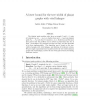Free Online Productivity Tools
i2Speak
i2Symbol
i2OCR
iTex2Img
iWeb2Print
iWeb2Shot
i2Type
iPdf2Split
iPdf2Merge
i2Bopomofo
i2Arabic
i2Style
i2Image
i2PDF
iLatex2Rtf
Sci2ools
84
Voted
CORR
2010
Springer
2010
Springer
A lower bound for the tree-width of planar graphs with vital linkages
The disjoint paths problem asks, given an graph G and k + 1 pairs of terminals (s0, t0), . . . , (sk, tk), whether there are k + 1 pairwise disjoint paths P0, . . . , Pk, such that Pi connects si to ti. Robertson and Seymour have proven that the problem can be solved in polynomial time if k is fixed. Nevertheless, the constants involved are huge, and the algorithm is far from implementable. The algorithm uses a bound on the treewidth of graphs with vital linkages, and deletion of irrelevant vertices. We give single exponential lower bounds both for the tree-width of planar graphs with vital linkages, and for the size of the grid necessary for finding irrelevant vertices.
Algorithm | Asks | CORR 2010 | Education | Polynomial Time |
| Added | 09 Dec 2010 |
| Updated | 09 Dec 2010 |
| Type | Journal |
| Year | 2010 |
| Where | CORR |
| Authors | Isolde Adler, Philipp Klaus Krause |
Comments (0)

